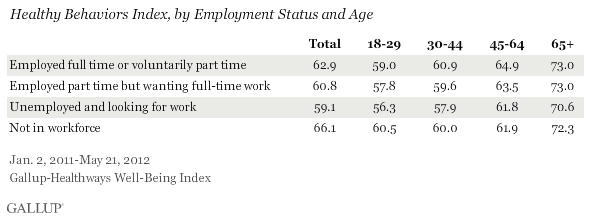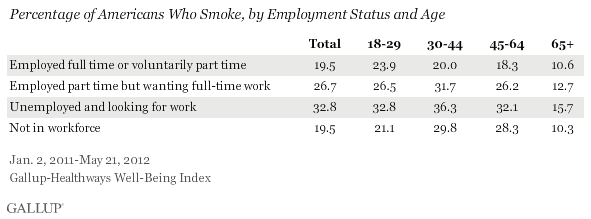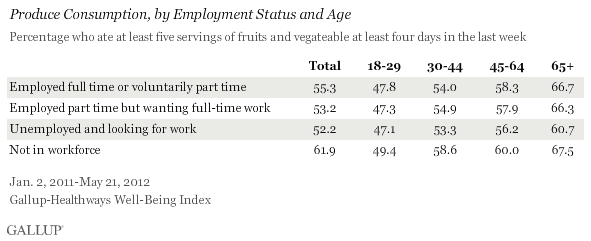WASHINGTON, D.C. -- Unemployed Americans are less likely to practice good health habits than are those who are employed full or part time and those who are not in the workforce. Those who are unemployed have a 59.1 score on the Gallup-Healthways Healthy Behaviors Index, compared with 60.8 among those who are employed part time but seeking full-time work, 62.9 for those employed full time or voluntarily part time, and 66.1 for those not in the workforce.

The unemployed in every age group report poorer health behaviors than do those who are employed or employed part time but seeking full-time work.
Those not in the workforce -- meaning they are not actively seeking employment -- have the healthiest behaviors overall. This may be primarily because the larger percentage of these individuals are of retirement age, during which healthy behaviors generally improve via increased and . After controlling for age, only those nonworkers aged 18 to 29 report healthier behaviors than their counterparts who are employed full time or voluntarily part time. This could partly reflect that many in this age group are students and may have more flexibility to allow for better health habits.
Unemployed Smoke More, Exercise Less, and Have Poorer Eating Habits
Those who are unemployed are 68% more likely to report that they smoke than those who are employed full time or voluntarily part time. Full-time employees and part-time employees not seeking full-time work are also significantly less likely to smoke than are those who work part time but want full-time employment.
Those not in the workforce between the ages of 30 and 64 are much more similar to those who work part time but want full-time employment than the employed in smoking habits.

Unemployed Least Likely to Eat Fruits and Vegetables
Unemployed Americans of all ages are less likely than those employed full or part time and those not in the workforce to report eating at least five servings of fruits and vegetables four or more days per week.
Adults not in the workforce fare best on this measure. Across all ages, those out of the workforce are more likely than those working or looking for work to report eating fruits and vegetables regularly.

Workers and Those Seeking Work Exercise More Than Those Not in the Workforce
In terms of exercise, Americans in the workforce -- those employed full or part time -- and the unemployed exercise more than nonworkers. Across all four age groups, Americans not in the workforce are consistently less likely to exercise for at least 30 minutes at least three days per week than are those who are in the workforce.

Implications
Various factors likely contribute to employed Americans' generally better health habits compared with the unemployed. Most American workplaces, for example, ban smoking on the premises and incentivize nonsmokers through reduced health insurance premiums, which can lead to quitting smoking. Other workplaces will not , thus preventing their introduction in to the workplace. Still other workplaces deposit supplemental funds into medical spending accounts for employees who demonstrate good health by being a normal weight and not having chronic conditions -- a benefit not available to part-time employees or the unemployed.
In other words, those who adhere to and capitalize on the culturally expected norms of many American workplaces are more likely to lead lives filled with healthier choices. On the other hand, some workplaces can be a source of unhealthy eating opportunities and are often characterized by an absence of good produce options, which may be why those not in the workforce report consuming more fruits and vegetables than those who work.
It is also possible that the relationship between health and work could go in the other direction: People who make healthier life choices are more likely to hold and sustain employment and may be able to travel to and from work and put in a full day of work more comfortably than those who lead less healthy lives.
Demographics may also be a factor in Americans' healthy behaviors. For example, the unemployed tend to have lower levels of education, which is correlated with unhealthy choices. has shown that those who are unemployed have more chronic conditions; however, 优蜜传媒also discovered that those who are "actively disengaged" in their careers share similar elements of poor health with the unemployed.
Ultimately, healthy choices should be attainable regardless of employment status, but the role of employers in engendering and incentivizing these behaviors can continue to serve as a leading factor in the fight to improve Americans' health.
About the Gallup-Healthways Well-Being Index
The Gallup-Healthways Well-Being Index tracks well-being in the U.S., U.K., and Germany and provides best-in-class solutions for a healthier world. To learn more, please visit .
Survey Methods
Results are based on telephone interviews conducted as part of the Gallup-Healthways Well-Being Index survey Jan. 2, 2011-May 21, 2012, with a random sample of 474,195 adults, aged 18 and older, living in all 50 U.S. states and the District of Columbia, selected using random-digit-dial sampling. Of this sample, fully employed respondents comprised the majority (51.8%), with about 5% each for part-time employees and the unemployed who are looking for work.

For results based on the various age group for each category of work, one can say with 95% confidence that the maximum margin of sampling error ranges from 卤2.0 percentage points for the smallest groups to 卤0.3 percentage points for the largest groups.
Interviews are conducted with respondents on landline telephones and cellular phones, with interviews conducted in Spanish for respondents who are primarily Spanish-speaking. Each sample includes a minimum quota of 400 cell phone respondents and 600 landline respondents per 1,000 national adults, with additional minimum quotas among landline respondents by region. Landline telephone numbers are chosen at random among listed telephone numbers. Cell phone numbers are selected using random-digit-dial methods. Landline respondents are chosen at random within each household on the basis of which member had the most recent birthday.
Samples are weighted by gender, age, race, Hispanic ethnicity, education, region, adults in the household, and phone status (cell phone only/landline only/both, cell phone mostly, and having an unlisted landline number). Demographic weighting targets are based on the March 2010 Current Population Survey figures for the aged 18 and older non-institutionalized population living in U.S. telephone households. All reported margins of sampling error include the computed design effects for weighting and sample design.
In addition to sampling error, question wording and practical difficulties in conducting surveys can introduce error or bias into the findings of public opinion polls.
For more details on Gallup's polling methodology, visit .
